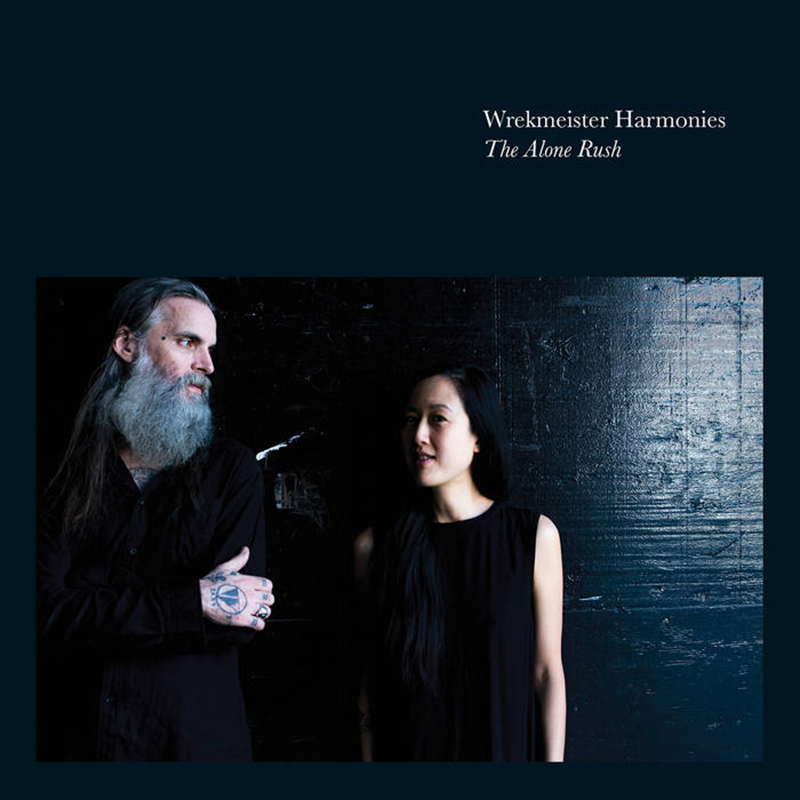Review: Wrekmeister Harmonies – The Alone Rush
National Music Reviews
Wrekmeister Harmonies
The Alone Rush
Thrill Jockey
Street: 04.13
Wrekmeister Harmonies = Low + Thomas Feiner + Dario Argento
Pared down to JR Robinson and Esther Shaw, Wrekmeister Harmonies left the familiar streets of Chicago for Astoria, Oregon, where they spent two years living in isolation. Reeling from tragedy and loss, the duo, augmented by Swans drummer Thor Harris and producer Martin Bisi, confronted death and loneliness head-on to create The Alone Rush, an atmospheric journey centered on Robinson’s robust baritone voice.
Wrekmeister Harmonies have never been easy to classify. Their penchant for slow-burning songs that build to massive crescendos echoes the structure of many compositions from Scottish act Mogwai. However, you’d never confuse the two, as Wrekmeister Harmonies are traditionally more influenced by distorted metal musings, rather than the chorused buzz of post-punk. I say “traditionally” because The Alone Rush is something of a departure for the band. The album’s heaviest moments, particularly in the cathartic, 14-minute epic, “Forgive Yourself and Let Go” feel more inspired by dissident jazz like late-period John Coltrane than Neurosis or Godflesh. This sonic change of direction might have something to do with Bisi, who has worked with an extremely diverse list of musicians, including the likes of Unsane, White Zombie and Helmet, but more importantly, Bill Laswell, Herbie Hancock and John Zorn.
Yet, these dissident moments are vastly outnumbered by sparse arrangements that feel theatrical in nature. Not cabaret, there’s no cheek here, but something you’d find delivered from a proscenium stage—grandiose and exaggerated, but delivered to an entirely empty house. Robinson’s vocals fill the space as Shaw’s plaintive violin and haunted backing vocals drift ethereally behind like a mist rising across above a forgotten lake. It’s beautiful, until you realize that the lyrics themselves often feel more in tune with Italian horror films than they do with the magical forests of a Studio Ghibli film. It’s Nick Cave‘s Murder Ballads all tangled up in Dante Alighieri’s Divine Comedy. Piss and blood, carnage and suffocation bathed in a vaporous light.
The album opens with “A 300 Year Old Slit Throat,” a song set among “crushed bones on courtyard stones.” A madness, a scar and the lingering taste of metal. Rather than building to a release, a siren’s call of Shaw’s backing vocal promises refuge but offers visions of a calf writhing in the grass as it bleeds out instead.
There is something sinister that exists beneath the seemingly calm surface of these songs. “Descent into Blindness,” the second track, begins in a similar, melancholy place as it builds to something darker, distorted and more menacing as Robinson cries out, “Leave the light on. Please leave the light on, I’m going blind. I’m going blind!” Each song blurs into the next with “Behold! The Final Scream” rising from the snarled end of “Descent into Blindness.” It’s a temporary respite as the beauty is transformed into a Hammer horror film as Christopher Lee stalks his inevitable prey with a sense of charm to hide his true intentions.
With “Covered in Blood from Invisible Wounds,” Robinson paints the canvas with “Arms and legs entwined in trees, the blood, the gore comes raining down upon me.” The aforementioned “Forgive Yourself and Let Go” follows. Its title suggests a moment of self-discovery, but the tension and chaos of the arrangement provides the listener with anything but a comforting epiphany. Even Shaw’s violin has turned from something soothing into something that shrieks.
The album closes with the title track, a shimmering exit from the dark that implies that, at least for the moment, there is a sense of hope as the madness of the forests burns to the ground.
It is a strange thing to stand outside of The Alone Rush. While inside its strange world, the macabre of it all doesn’t feel nearly as dark and damning. There is a lightness that betrays the sinking sense of desperation. Yes, there is a formula at work here, but inside the dream, it feels less structured than it really is. Each of the six tracks suggests a journey and while each could stand alone, the experience is best taken in as a whole. Lost and forced into a descent into madness, The Alone Rush is also a cry of hope, a strong desire to find a way back home. –ryanmichaelpainter
